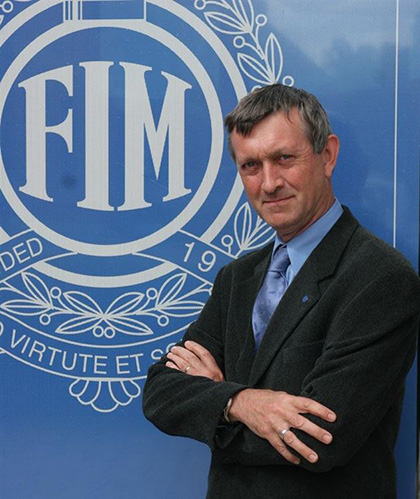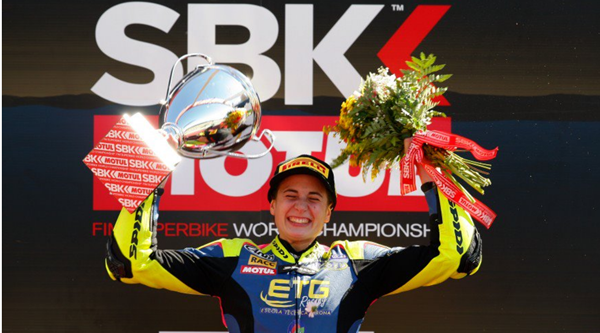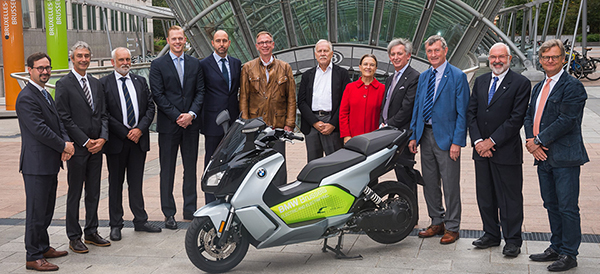
FIM Europe – Our latest article at Motorcycle Minds is this feature direct from FIM Europe, in which FIM Europe Director of Public Affairs John Chatterton-Ross reflects on 2017. Although we are aware of what FIM Europe “does” and who represents the organisation as we present the article, we are not sure if you do.
However, to start with, here is a briefing on what FIM Europe is which suggests that it is more associated as a “traditional” rider organisation than you might think.
FIM Europe is made up of:
Seven National Federations (FMNs) and 6 Regional Motorcycling Associations and is a European organization acting within its attributions in all matters in relation with motorcycling activities and, as such, in domains ranging from sport, tourism, leisure, environment, mobility, road safety, legislative affairs, protection and defence of the rights and interests of motorcycle users.
As far as motorcycle sport is concerned, the FIM Europe is the supreme and sole European authority empowered by the FIM to control European motorcycling sport activities organized under its jurisdiction throughout Europe.
The aims of FIM Europe are to develop and promote all forms of motorcycling in Europe as well as the cooperation and friendship between its members, and notably:
to examine all questions related to the development of motorcycling in Europe; to organize European Championships and to establish all competitions that appear beneficial subject to the prior approval of the FIM;
to co-operate with the FIM in all matters relating to the organization of international events and motorcycling in general; to organize camps and seminars for riders, officials, coaches and administrators of various European FMNs;
to support the creation and development of motorcycling activities in all European countries; to promote the co-operation among all European FMNs; to promote motorcycling among young people, both as sport and motorcycling in general; to encourage the use of motorcycles in European countries and to develop motorcycle tourism;
to represent the interests of motorcyclists before European authorities; to promote in the media the sport of motorcycling and the use of motorcycles in all of Europe.
Reflecting from the perspective of a “rider organisation”, FIM Europe Director of Public Affairs John Chatterton-Ross has picked out some aspects of 2017.
FIM Europe Director of Public Affairs John Chatterton-Ross reflects on 2017
Q. What was your highlight of 2017?
A. The 17th September when Ana Carrasco won the World Championship Supersport 300 race!
Q. That is a surprising answer from our representative to Brussels, any connection from Ana’s win to the work you do?
A. That is why it is my highlight of 2017. Motorcycling needs more women riders. In sport this is significant. We see nothing unusual in women and men competing on equal terms in equestrian sports. To see this in motorcycling sport is fantastic.
It is good the 300cc category is promoted as these motorcycles are cost effective for sport and road use, and as Ana proved on the track, a woman can race as well as any man. It is good politically too, making motorcycling more mainstream. Not just an activity for men.

Q. Are there other barriers to more women riding?
A. A woman can drive a large car as well as a small one. The seats can be adjusted. With motorcycles there is little effort by the manufacturers to make bikes that fit women and shorter men. I have no idea why motocross derived suspension is used on many road motorcycles. It is more expensive, and in winter riding the risk of corrosion to the linkage is considerable if you are riding in wet climates. It makes the seat height very high. It is completely pointless as a road motorcycle does not need a large range of suspension movement.
This means many women and shorter men have to buy the cruiser style motorcycle if they want a low seat and larger engine. This is fine for some, but not for everyone. Cruisers are great on long straight roads but that is far from the case in many parts of Europe.
Q. Is there any sign of progress?
A. Some manufacturers are now entering what is called the “world” motorcycle market. Motorcycles that can be sold in all markets with a mid-sized engine and in a variety of styles that do not end up with a very high seat. There are signs that production will be centred in India, in partnerships between companies from the west or Japan with Indian companies.
Q. What about developments in the industry generally?
A. The motorcycle industry is global. In Europe France is the country where the new Yamaha MT 125cc is manufactured. Germany, Italy, Spain, the UK and Austria are also major motorcycle manufacturing countries. When it comes to factories outside of Europe then companies have very different approaches.
Most have joint ventures with others – this is seen with many examples in India. The exception is Triumph with their three factories in Thailand. These are fully owned by Triumph and run by Triumph management. There is frequent exchange of production between those plants and the two back in the UK.
Q. Of all the issues in Brussels is there one that really stands out as a problem?
A. Yes. The Vnuk case. This threat has hung over the sport since the judgment was given in 2014. Together with the FIA we are making progress to an eventual solution. President Dr Srb was appointed to lead this work by FIM President Ippolito. A survey was sent to all affected FMNs and the result was the same opinion as the FIA and the insurance industry on the best way forward. The EU Commission received over 3500 responses to its consultation.
Q. Is that a lot for an issue like this?
A. Yes, normally these consultations only attract replies of a few hundred stakeholders. It shows how many sectors are affected. I am sure the scale of the response will result in more delays before a revising text is sent to the European Parliament and Council. We are well prepared for the time we reach that stage.
Q. Are there any issues that have been finalised in 2017?
A. 2017 saw the publication of the GEAR 2030 report by the European Union. The final meeting was attended by FIM Board member Jos Driessen in the Berlaymont building in Brussels. This deals with the strategic future of the motorcycle and automotive industries in Europe. Now comes the implementation of the recommendations.
Q. Any in particular?
A. Yes, for Europe to make progress on battery electric vehicles there is a lot to do as the report points out. We need much more infrastructure and also more to be done on battery production. Otherwise electric vehicles will remain as they are today – very expensive and a tiny proportion compared to petrol.
Q. It is now established to hold a conference within the context of the annual FIM Europe Congress. How do you feel the event went this year?
A. I think the team led by Jean-Pierre Moreau and Silvio Manicardi did a great job. It was an honour for us that member of the European Parliament Wim van de Camp came and spoke. Not only at the conference but also next day at the General Assembly. We also had time to speak with him at length informally over the weekend. Earlier in the year President Dr Srb and Vice President Martin de Graaff held talks with him in Brussels.
The theme was well chosen as the subject of “connected vehicles” is important for the future.
Q. Why do you say that?
A. There is the potential to reduce collisions particularly at junctions outside of towns where often speeds are higher. We know that this type of collision is a major factor in road safety.
Q. Does this also fit with all the stories in the media now about automated and semi-automated cars?
A. Yes, it is all part of the same picture. I would stress that the fully automated car with no steering wheel, no controls, no driver – only passengers! Is still a long way in the future.
Q. What about semi-automated cars that riders have to share the roads with?
A. They are already with us!
Q. Really?
A. Yes. Now mainly on premium cars but we will soon see these features on more cars. Systems include:
- Autonomous emergency braking (both at city speeds and for highway use)
- Lane assist – where if the driver loses concentration there is a warning and a small automatic correction of the steering
- Road sign recognition that helps with the speed limit being shown inside the car on the control panel
- Advanced cruise control
- Systems that help the driver park easily in a small space
There are claims by some companies that their safety systems also recognise pedestrians, cyclists and large animals. As we saw with a collision in Norway when a Tesla car hit the rear end of a motorcycle they do not always recognise motorcycles.

Q. Staying with the FIM Europe Congress this year – any other aspects that connect with your work and that of the team led by Jean-Pierre Moreau?
A. Yes. The 2017 Congress saw the launch of revised agreed position papers between FIM Europe and FEMA. These were written in 2015 and the plan is to revise them every two years as we did this year.
Anyone can write a long document – and it won’t be read by busy politicians and officials. These are short precise papers on all the main issues we face today. Any FMN in any part of FIM Europe can use these papers with national and local authorities.
(The position papers can be found at the following link: http://www.fim-europe.com/wp-content/uploads/2017/08/Position-Papers-2017-FINAL-per-Website.pdf)
We said a formal goodbye to Morten Hansen from Norway who was chair of the co-operation group. He has now retired from his work in motorcycling. He is still a rider! For 2018 Francesca Marozza of FMI will chair the group.
Q. You mentioned battery electric when speaking about the GEAR 2030 report. That was the theme for the FIM annual debate in Brussels?
A. Yes, as you see in the photograph BMW kindly loaned us one of their new scooters for the photocall outside the EU Parliament in Brussels.
This scooter uses the technology that BMW employ in their electric car although it needs a smaller number of cells than the car – but they are the same design.
Amongst the speakers were students from the STORM project in the Netherlands. They designed, built and rode an electric motorcycle around the world in eighty days (https://www.storm-eindhoven.com)
The panel included speakers from industry, those involved with scooter renting systems in cities and Greg Archer from the environmental campaigning organisation Transport and Environment which is very active in Brussels.
Q. Finally, earlier in the year we spoke about motorcycle clothing and new laws coming in 2018. Any more news?
A. I will make a presentation on this to a conference in Finland early in 2018. In April the new law will come into force and motorcycling clothing will have to be tested as a whole garment. Not just the impact protectors. I think the situation for riders will be very confusing.
Fortunately, much of the clothing sold in Europe is identical to that marketed in Australia and New Zealand. They are developing a star rating system for assessing clothing. I think that will be very useful and with the internet we will be able to access the information here in Europe too.
This will be our duty, as FIM Europe Administration, for the future.
We wish John and FIM Europe all the best for 2018 and as ever, will follow closely and report to you the rider what they are involved in during the forthcoming year.
Original Source – FIM Europe Director of Public Affairs John Chatterton-Ross reflects on 2017
FIM Europe – www.fim-europe.com
On Facebook – www.facebook.com/fimeurope/
Latest Edition of – FIM Europe MAG


FEMA – Presidents New Year’s Address
Presidents New Year’s Address
In the year that lies behind us, every discussion, every conference and every political meeting seemed to have the same subjects: semi-automated cars, connected vehicles and futuristic scenarios in which the rider or driver has no real role to play anymore.
Too often it seems that ‘the powers that be’ are looking at the future of personal transport without taking into account the wishes and desires of people like you and me, motorcyclists. But then I talk to the FEMA staff, General Secretary Dolf Willigers and Communications Officer Wim Taal, and I know that they take every opportunity to let the voice of European riders be heard in those conversations.
Thanks to our staff’s unwavering commitment, FEMA is able to make a real difference and to make sure that the ‘visibility’ of motorcycles and other powered two-wheelers is now part of the development and testing of ADAS, Advanced Driver Assistance Systems in cars.
Another subject that’s always on the agenda now is promotion of ‘clean’ energy, i.e. electricity, in personal transport. Within FEMA we are fully aware that this one of the ways to reduce the need for natural resources, and we support these developments. However, as an organization that has its roots firmly planted in the European motorcyclists’ community, we talk to you, the riders, and – more importantly – listen to you and hear your concerns.
Coming from a generation of riders that secretly love the smell of petrol and that aren’t scared by a bit of oil dripping from the engine case, I understand the hesitation to embrace clean, electric bikes. So if asked about our future and when people want to know whether there will be room for the motorcycles that we know and love, it’s best to quote Dolf Willigers, as he says “FEMA sees a future for electric motorcycles and motorcycles with an internal combustion engine side by side”.
FEMA will keep fighting for the ride to ride whatever motorcycle, wherever and whenever you want. Not just because we want to preserve the growing fleet of vintage and historical motorcycles as a testimony to the human spirit of ingenuity and technical innovation, but because we strongly believe that all motorcycles, however they are powered, deserve a place on the road – together with you, their riders.
That’s what FEMA’s about – it just remains for me to wish you a 2018 full of two-wheeled fun!
Anna Zee, President.
However, we have some concerns when looking back to a recently publicized FEMA meeting in October where there was a discussion regarding motorcycle sound/noise.
We will have a full article on the issue of motorcycle noise/enforcement/changes sound levels, which FEMA in October also discussed. One issue which stood out was:
“All were in agreement that the “loud pipes saves lives” argument was obsolete – and the idea was universally condemned by delegates”
While the FEMA President in her address states, “As an organization that has its roots firmly planted in the European motorcyclists’ community, we talk to you, the riders, and – more importantly – listen to you and hear your concerns.” We would however question the argument that “loud pipes saves lives” obsolete.
Is there room for maneuvre on certain aspects of this debate?
Does universal condemnation give no room for maneuvre? Do you simply have to agree with the legislators and the politicians that there is no argument to have around quieter and quieter overall noise e.g. engines and general transportation street noise?
Are riders being convinced that the philosophy of “Loud Pipes Save Lives” is no longer valid?
Original Source – FEMA – Presidents new year’s address